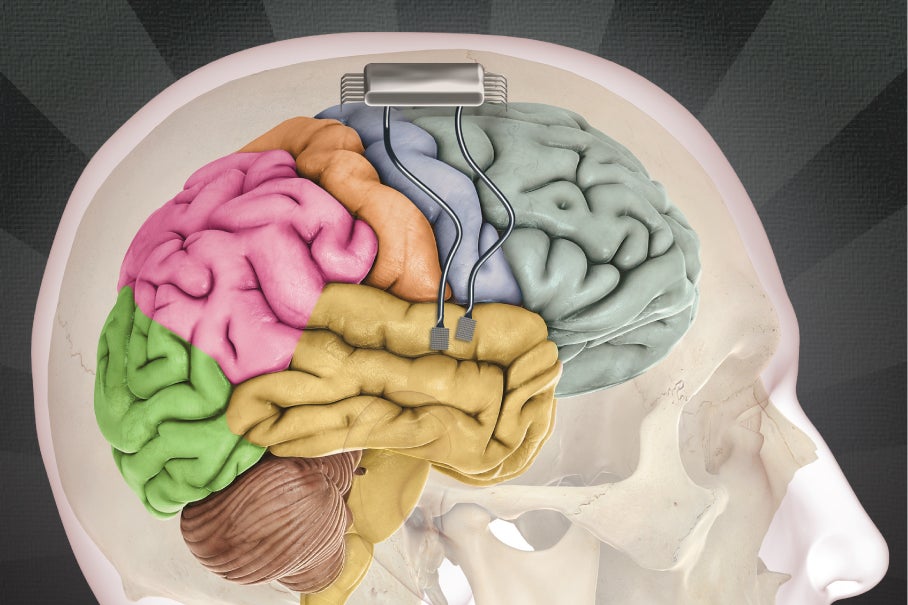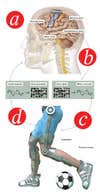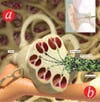How Neuroscience Will Fight Five Age-Old Afflictions
Rewiring the brain to battle seizures, blindness, and more


Rewiring The Brain: Seizures
1) SEIZURES
A device delivers targeted drugs to calm overactive neurons
For years, large clinical trials have treated people with epilepsy using so-called deep-brain stimulation: surgically implanted electrodes that can detect a seizure and stop it with an electrical jolt. The technology leads to a 69 percent reduction in seizures after five years, according to the latest results.
Tracy Cui, a biomedical engineer at the University of Pittsburgh, hopes to improve upon that statistic. Her group has designed an electrode that would deliver both an electrical pulse and antiseizure medication. “We know where we want to apply the drug,” Cui says, “so you would not need a lot of it.”
To build the device, Cui’s team immersed a metal electrode in a solution containing two key ingredients: a molecule called a monomer and the drug CNQX. Zapping the solution with electricity causes the monomers to link together and form a long chain called a polymer. Because the polymer is positively charged, it attracts the negatively charged CNQX, leaving the engineers with their target product: an electrode coated in a film that’s infused with the drug.
The researchers then placed the electrodes in a petri dish with rat neurons. Another zap of electricity disrupted the electrostatic attraction in the film, causing the polymer to release its pharmacological payload—and nearby cells to quiet their erratic firing patterns. Cui says her team has successfully repeated the experiment in living rats. Next, she’d like to test the electrodes in epileptic rats and then begin the long process of regulatory approval for human use.
The body’s blood-brain barrier protects the organ from everything but the smallest molecules, rendering most drugs ineffective. As a result, this drug-delivery mechanism could treat other brain disorders, Cui says. The electrodes can be loaded with any kind of small drug—like dopamine or painkillers—
making it useful for treating Parkinson’s disease, chronic pain, or even drug addiction.

Rewiring The Brain: Dementia
2) DEMENTIA
Electrode arrays stimulate mental processing
Dementia is one of the most well-known and frustrating brain afflictions. It damages many of the fundamental cognitive functions that make us human: working memory, decision-making, language, and logical reasoning. Alzheimer’s, Huntington’s, and Parkinson’s diseases all lead to dementia, and it’s also sometimes associated with multiple sclerosis, AIDS, and the normal process of aging.
Theodore Berger, a biomedical engineer at the University of Southern California, hopes to help people stave off the symptoms of dementia with a device implanted in the brain’s prefrontal cortex, a region crucial for sophisticated cognition. He and colleagues at Wake Forest Baptist Medical Center tested the device in a study involving five monkeys and a memory game.
First the team implanted an electrode array so that it could record from layers 2/3 and 5 of the prefrontal cortex and stimulate layer 5. The neural signals that jet back and forth between these areas relate to attention and decision-making. The team then trained the monkeys to play a computer game in which they saw a cartoon picture—such as a truck, lion, or paint palette—and had to select the same image from a panel of pictures 90 seconds later.
The scientists initially analyzed the electrical signals sent between the two cortical layers when the monkeys made a correct match. In later experiments, the team caused the array to emit the same signal just before the monkey made its decision. The animals’ accuracy improved by about 10 percent. That effect may be even more profound in an impaired brain. When the monkeys played the same game after receiving a hit of cocaine, their performance dropped by about 20 percent. But electrical stimulation restored their accuracy to normal levels.
Dementia involves far more complicated circuitry than these two layers of the brain. But once scientists better understand exactly how dementia works, it may be possible to combine several implants to each target a specific region.

Rewiring The Brain: Blindness
3) BLINDNESS
Gene therapy converts cells into photoreceptors, restoring eyesight
Millions of people lose their eyesight when disease damages the photoreceptor cells in their retinas. These cells, called rods and cones, play a pivotal role in vision: They convert incoming light into electrical impulses that the brain interprets as an image.
In recent years, a handful of companies have developed electrode-array implants that bypass the damaged cells. A microprocessor translates information from a video camera into electric pulses that stimulate the retina; as a result, blind subjects in clinical trials have been able to distinguish objects and even read very large type. But the implanted arrays have one big drawback: They stimulate only a small number of retinal cells—about 60 out of 100,000—which ultimately limits a person’s visual resolution.
A gene therapy being developed by Michigan-based RetroSense could replace thousands of damaged retinal cells. The company’s technology targets the layer of the retina containing ganglion cells. Normally, ganglion cells transmit the electric signal from the rods and cones to the brain. But RetroSense inserts a gene that makes the ganglion cells sensitive to light; they take over the job of the photoreceptors. So far, scientists have successfully tested the technology on rodents and monkeys. In rat studies, the gene therapy allowed the animals to see well enough to detect the edge of a platform as they neared it.
The company plans to launch the first clinical trial of the technology next year, with nine subjects blinded by a disease called retinitis pigmentosa. Unlike the surgeries to implant electrode arrays, the procedure to inject gene therapy will take just minutes and requires only local anesthesia. “The visual signal that comes from the ganglion cells may not be encoded in exactly the fashion that they’re used to,” says Peter Francis, chief medical officer of RetroSense. “But what is likely to happen is that their brain is going to adapt.”

Rewiring The Brain: Paralysis
4) PARALYSIS
A brain-machine interface controls limbs while sensing what they touch
Last year, clinical trials involving brain implants gave great hope to people with severe spinal cord injuries. Two paralyzed subjects imagined picking up a cup of coffee. Electrode arrays decoded those neural instructions in real time and sent them to a robotic arm, which brought the coffee to their lips.
But to move limbs with any real precision, the brain also requires tactile feedback. Miguel Nicolelis, a biomedical engineer at Duke University, has now demonstrated that brain-machine interfaces can simultaneously control motion and relay a sense of touch—at least in virtual reality.
For the experiment, Nicolelis’s team inserted electrodes in two brain areas in monkeys: the motor cortex, which controls movement, and the nearby somatosensory cortex, which interprets touch signals from the outside world. Then the monkeys played a computer game in which they controlled a virtual arm—first by using a joystick and eventually by simply imagining the movement. The arm could touch three identical-looking gray circles. But each circle had a different virtual “texture” that sent a distinct electrical pattern to the monkeys’ somatosensory cortex. The monkeys learned to select the texture that produced a treat, proving that the implant was both sending and receiving neural messages.
This year, a study in Brazil will test the ability of 10 to 20 patients with spinal cord injuries to control an exoskeleton using the implant. Nicolelis, an ardent fan of Brazilian soccer, has set a strict timetable for his team: A nonprofit consortium he created, the Walk Again Project, plans to outfit a paraplegic man with a robotic exoskeleton and take him to the 2014 World Cup in São Paulo, where he will deliver the opening kick.

Rewiring The Brain: Deafness
5) DEAFNESS
Stem cells repair a damaged auditory nerve, improving hearing
Over the past 25 years, more than 30,000 people with hearing loss have received an electronic implant that replaces the cochlea, the snail-shaped organ in the inner ear whose cells transform sound waves into electrical signals. The device acts as a microphone, picking up sounds from the environment and transmitting them to the auditory nerve, which carries them on to the brain.
But a cochlear implant won’t help the 10 percent of people whose profound hearing loss is caused by damage to the auditory nerve. Fortunately for this group, a team of British scientists has found a way to restore that nerve using stem cells.
The researchers exposed human embryonic stem cells to growth factors, substances that cause them to differentiate into the precursors of auditory neurons. Then they injected some 50,000 of these cells into the cochleas of gerbils whose auditory nerves had been damaged. (Gerbils are often used as models of deafness because their range of hearing is similar to that of people.) Three months after the transplant, about one third of the original number of auditory neurons had been restored; some appeared to form projections that connected to the brain stem. The animals’ hearing improved, on average, by 46 percent.
It will be years before the technique is tested in humans. Once it is, researchers say, it has the potential to help not only those with nerve damage but also people with more widespread impairment whose auditory nerve must be repaired in order to receive a cochlear implant.
This article originally appeared in the March 2013 issue of the magazine.